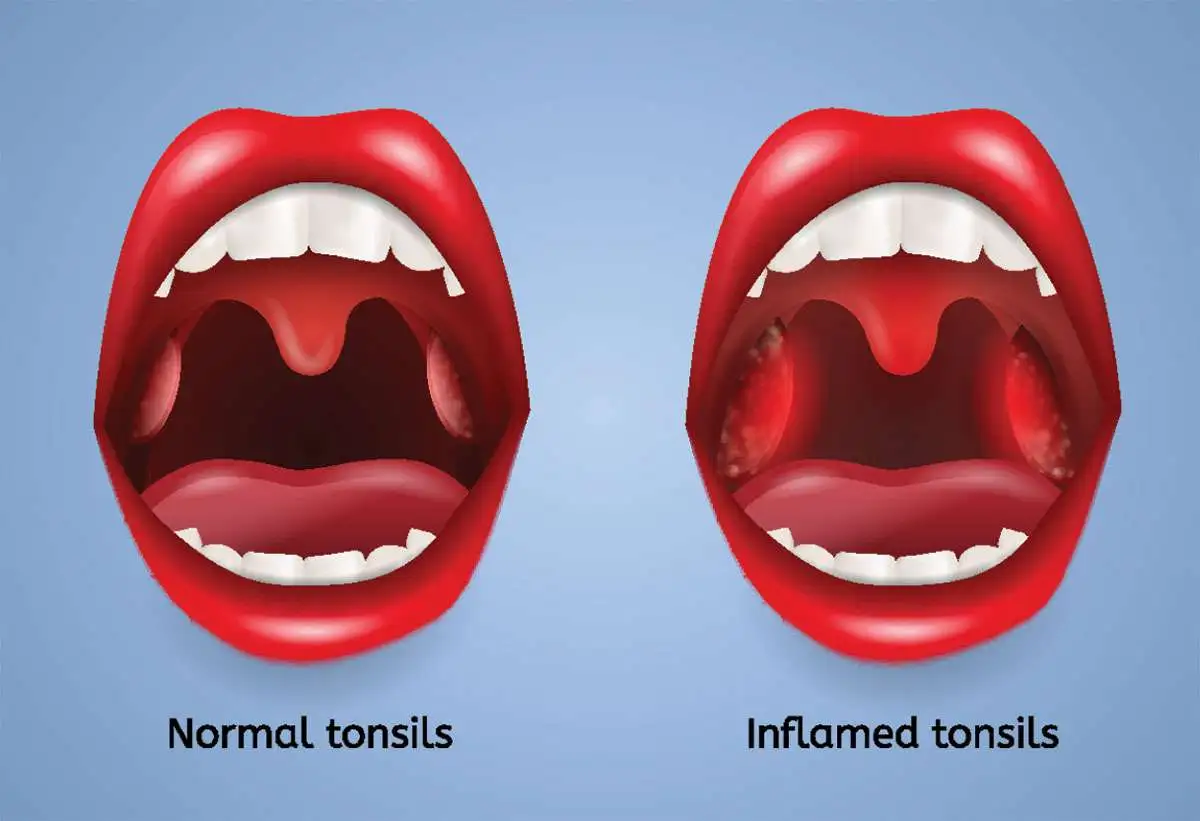The tonsils are a pair of small organs located at the back of the throat, known as the pharynx. They are part of the lymphatic system and play a crucial role in the body’s immune response, particularly during childhood. Tonsils help to trap bacteria and viruses that enter the body through the mouth and nose, preventing them from causing infections. However, in some cases, tonsils can become infected or enlarged, leading to recurrent infections or other health issues. When conservative treatments fail to alleviate symptoms, a tonsillectomy may be recommended. But Can Tonsils Grow Back After Being Removed? – Tymoff Let’s explore this question further.
Understanding Tonsils and Their Functions
“Can Tonsils Grow Back After Being Removed? – Tymoff” Tonsils are made up of lymphoid tissue and are part of the body’s immune system. They are located on either side of the throat, at the back of the mouth. The tonsils are the first line of defense against pathogens that enter the body through the mouth and nose. They help to trap bacteria and viruses, preventing them from entering the respiratory or gastrointestinal tract and causing infections. Tonsils also produce antibodies that help to fight off infections and strengthen the immune response.
Tonsillectomy: Reasons and Procedures
A tonsillectomy is a surgical procedure to remove the tonsils. It is typically performed to treat recurrent throat infections, chronic tonsillitis, or obstructive sleep apnea.”Can Tonsils Grow Back After Being Removed? – Tymoff” The decision to undergo a tonsillectomy is usually based on the frequency and severity of tonsil infections or other related conditions.

Indications for Tonsillectomy
- Recurrent Tonsillitis: Frequent episodes of tonsillitis that do not respond to antibiotics may necessitate removal of the tonsils.
- Chronic Tonsillitis: Persistent inflammation of the tonsils that leads to discomfort, difficulty swallowing, and other complications.
- Obstructive Sleep Apnea: Enlarged tonsils can obstruct the airway during sleep, leading to breathing difficulties and interrupted sleep patterns.
The Tonsillectomy Procedure
A tonsillectomy is usually performed under general anesthesia and takes about 30 to 45 minutes to complete.”Can Tonsils Grow Back After Being Removed? – Tymoff” The surgeon may use one of several methods to remove the tonsils:
- Traditional Surgery: The tonsils are removed using a scalpel.
- Laser Surgery: A laser is used to vaporize the tonsil tissue.
- Electrocautery: Heat or electrical current is used to remove the tonsils.
After the procedure, the patient is usually monitored for a few hours in a recovery room before being discharged home the same day.
Recovery and Aftercare
Recovery from a tonsillectomy typically takes one to two weeks. During this time, patients may experience pain, difficulty swallowing, and earaches.”Can Tonsils Grow Back After Being Removed? – Tymoff” It is essential to follow the doctor’s instructions for pain management and to avoid strenuous activities during the recovery period. Patients are also advised to stay hydrated and consume soft foods to prevent irritation of the throat.

Can Tonsils Grow Back After Being Removed?
While it is possible for tonsils to regrow after partial removal, it is unlikely for them to grow back completely after a complete tonsillectomy.”Can Tonsils Grow Back After Being Removed? – Tymoff” In most cases, the surgeon removes the entire tonsil, including the tonsillar tissue and the tonsillar fossa, where the tonsil is located. However, in rare instances, small amounts of tonsil tissue may remain or regrow, especially if the procedure was performed on very young children. This residual tissue may not cause any symptoms and may not require further treatment.
Conclusion
In conclusion, “Can Tonsils Grow Back After Being Removed? – Tymoff” a tonsillectomy is a common surgical procedure performed to treat various conditions related to the tonsils, such as recurrent infections and obstructive sleep apnea. While tonsils can regrow after partial removal, it is rare for them to grow back completely after a complete tonsillectomy. Patients undergoing a tonsillectomy should follow their doctor’s instructions for a smooth recovery and consult their healthcare provider if they experience any complications or concerns.
Frequently Asked Questions About “Can Tonsils Grow Back After Being Removed? – Tymoff”
Q1. Can tonsils actually grow back after they’ve been surgically removed?
A1. No, tonsils cannot grow back after they have been surgically removed through a procedure known as tonsillectomy. However, in some cases, remnants of tonsil tissue may regrow or reform, leading to the perception that the tonsils have grown back. This is rare and usually involves only a small amount of tissue.
Q2. Why do people sometimes think their tonsils have grown back?
A2. People may think their tonsils have grown back due to the regrowth of a small amount of tonsil tissue or the development of scar tissue in the tonsil bed following tonsillectomy. This can occur if the surgeon does not remove the entire tonsil tissue during the initial procedure. Additionally, symptoms such as sore throat or swollen glands in the throat area may be mistakenly attributed to the regrowth of tonsils.
Q3. Is it possible for tonsil tissue to regrow after a tonsillectomy?
A3. While it’s rare, some instances have been reported where small amounts of tonsil tissue regrow or reform after a tonsillectomy. This regrowth is often minimal and typically does not lead to the full restoration of the tonsils. However, it can cause symptoms similar to those experienced before the tonsillectomy, leading individuals to believe their tonsils have grown back.
Q4. What are the signs that tonsils may have regrown after being removed?
A4. Signs that tonsils may have regrown or that remnants of tonsil tissue remain after a tonsillectomy include:
Recurring or persistent sore throat
Swelling or inflammation in the throat area
Difficulty swallowing or breathing
Chronic or recurrent tonsil infections
Enlargement of lymph nodes in the neck
Q5. Can scar tissue in the tonsil bed cause symptoms similar to regrown tonsils?
A5. Yes, scar tissue in the tonsil bed can cause symptoms similar to regrown tonsils. After a tonsillectomy, scar tissue forms in the area where the tonsils were removed. “Can Tonsils Grow Back After Being Removed? – Tymoff” This scar tissue may sometimes be mistaken for regrown tonsil tissue, especially if it causes symptoms such as sore throat or difficulty swallowing. However, scar tissue does not represent the actual regrowth of tonsil tissue.
Q6. Are there any complications associated with tonsil regrowth or remnants after tonsillectomy?
A6. In most cases, regrowth of tonsil tissue or remnants after tonsillectomy does not lead to significant complications. However, if the regrowth is substantial or causes recurrent infections or other symptoms, further medical evaluation may be necessary. “Can Tonsils Grow Back After Being Removed? – Tymoff” Additionally, scar tissue in the tonsil bed can sometimes contribute to symptoms such as difficulty swallowing or breathing, although this is rare.
Q7. How common is it for tonsils to regrow after being surgically removed?
A7. Tonsil regrowth after surgical removal, known as tonsillectomy, is rare. The procedure is typically performed to completely remove the tonsils, leaving little to no tissue remaining. However, in some cases, small amounts of tonsil tissue may regrow or remnants may be left behind. “Can Tonsils Grow Back After Being Removed? – Tymoff” While uncommon, this can lead to symptoms similar to those experienced before the tonsillectomy.
Q8. What should someone do if they suspect their tonsils have regrown after a tonsillectomy?
A8. If someone suspects their tonsils have regrown or if they experience symptoms similar to those before the tonsillectomy, they should consult with an ear, nose, and throat (ENT) specialist or their healthcare provider for evaluation. “Can Tonsils Grow Back After Being Removed? – Tymoff” A thorough examination, including visual inspection of the throat and possibly imaging studies, can help determine the cause of the symptoms and guide appropriate treatment.
Q9. Can tonsils regrow in children after a tonsillectomy?
A9. Tonsil regrowth after tonsillectomy is extremely rare in children, as in adults. The procedure is typically performed to remove the tonsils completely, leaving minimal to no tissue behind. “Can Tonsils Grow Back After Being Removed? – Tymoff” However, if a child experiences symptoms suggestive of tonsil regrowth, such as recurrent sore throat or difficulty swallowing, they should be evaluated by a healthcare professional for further assessment and management.
Q10. What are the reasons for tonsillectomy, and how effective is the procedure?
A10. Tonsillectomy is commonly performed to treat recurrent tonsillitis (inflammation of the tonsils) or other tonsil-related conditions that do not respond to conservative treatment. The procedure is highly effective in relieving symptoms and reducing the frequency and severity of tonsil-related infections in most cases. “Can Tonsils Grow Back After Being Removed? – Tymoff” However, as with any surgical procedure, there are risks and potential complications, and the decision to proceed with tonsillectomy should be made based on careful consideration of the individual’s medical history and symptoms.
Q11. Is it possible for tonsil regrowth to occur years after a tonsillectomy?
A11. “Can Tonsils Grow Back After Being Removed? – Tymoff” While it’s uncommon, tonsil regrowth or the development of scar tissue in the tonsil bed can occur years after a tonsillectomy. However, such instances are rare and typically occur within the first few years following the procedure. If someone experiences symptoms suggestive of tonsil regrowth years after a tonsillectomy, they should consult with a healthcare professional for evaluation.
Q12. Can tonsil regrowth be prevented after a tonsillectomy?
A12. “Can Tonsils Grow Back After Being Removed? – Tymoff” There is no guaranteed way to prevent tonsil regrowth after a tonsillectomy. However, ensuring that the tonsils are completely removed during the procedure and following post-operative care instructions can minimize the risk. It’s essential to follow up with the surgeon for scheduled check-ups to monitor healing and address any concerns promptly.
Q13. Are there any factors that increase the risk of tonsil regrowth after a tonsillectomy?
A13. “Can Tonsils Grow Back After Being Removed? – Tymoff” While tonsil regrowth after tonsillectomy is rare, certain factors may increase the risk, including incomplete removal of the tonsils during the initial procedure, underlying medical conditions affecting healing, and individual variations in healing processes. Additionally, inadequate post-operative care or complications during the healing process may contribute to the development of scar tissue or regrowth.
Q14. What is the typical recovery period after a tonsillectomy, and when should someone seek medical attention for persistent symptoms?
A14. “Can Tonsils Grow Back After Being Removed? – Tymoff” The recovery period after a tonsillectomy typically ranges from 1 to 2 weeks, during which time individuals may experience throat pain, difficulty swallowing, and mild ear pain. However, if symptoms persist or worsen beyond the expected recovery period, or if new symptoms develop, such as fever, bleeding, or difficulty breathing, medical attention should be sought promptly to rule out complications.
Q15. Can tonsil regrowth occur if only one tonsil is removed during a tonsillectomy?
A15. “Can Tonsils Grow Back After Being Removed? – Tymoff” Tonsil regrowth is rare, regardless of whether one or both tonsils are removed during a tonsillectomy. However, if only one tonsil is removed and the other remains intact, the risk of tonsil-related symptoms persisting or recurring may be higher. In such cases, careful monitoring of symptoms and follow-up with a healthcare professional are essential to ensure proper management.
